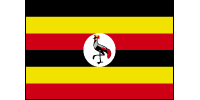| Country (long form) |
Republic of Uganda |
| Capital |
Kampala |
| Total Area |
91,135.55 sq mi
236,040.00 sq km
(slightly smaller than Oregon) |
| Population |
23,985,712 (July 2001 est.)
note: estimates for this country explicitly take into account the effects of excess mortality due to AIDS; this can result in lower life expectancy, higher infant mortality and death rates, lower population and growth rates, and changes in the distribution of population by age and sex than would otherwise be expected |
| Estimated Population in 2050 |
84,108,178 |
| Languages |
English (official national language, taught in grade schools, used in courts of law and by most newspapers and some radio broadcasts), Ganda or Luganda (most widely used of the Niger-Congo languages, preferred for native language publications in the capital and may be taught in school), other Niger-Congo languages, Nilo-Saharan languages, Swahili, Arabic |
| Literacy |
61.8% total, 73.7% male, 50.2% female (1995 est.) |
| Religions |
Roman Catholic 33%, Protestant 33%, Muslim 16%, indigenous beliefs 18% |
| Life Expectancy |
42.59 male, 44.17 female (2001 est.) |
| Government Type |
republic |
| Currency |
1 Ugandan shilling (USh) = 100 cents |
| GDP (per capita) |
$1,100 (2000 est.) |
| Industry |
sugar, brewing, tobacco, cotton textiles, cement |
| Agriculture |
coffee, tea, cotton, tobacco, cassava (tapioca), potatoes, corn, millet, pulses; beef, goat meat, milk, poultry |
| Arable Land |
25% |
| Natural Resources |
copper, cobalt, hydropower, limestone, salt, arable land |
|


|